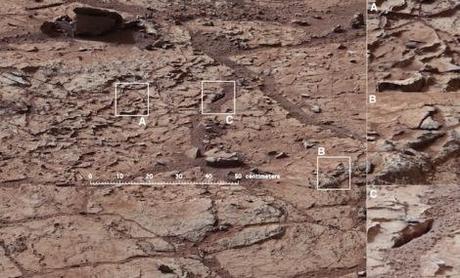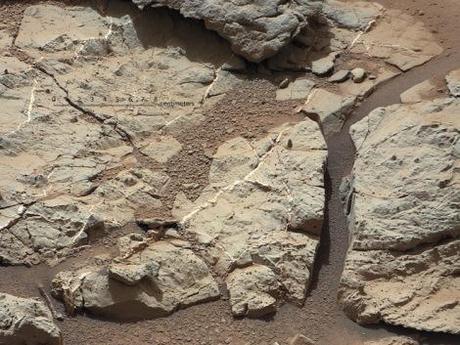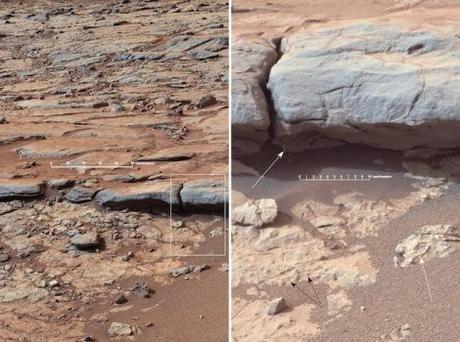NASA’s Curiosity rover has explored a new area on Mars called Yellowknife Bay. Yellowknife Bay shows plenty of evidence of flowing water since it was basically an ancient riverbed. And now, the rover is preparing to drill into a veined rock nicknamed “John Klein” in the location in the next couple weeks, investigating its composition and searching for organics. The area contains a wide diversity of rock types and this will be the first time that engineers have drilled into the surface of another planet.

Now they are uncovering the complex geologic history of the area and have stumbled across many interesting features.
Here, some of the minerals are sedimentary, suggesting that flowing water moved small grains around and deposited them, and other evidence suggests water moved through the rocks after they had formed. Tiny spherical concretions scattered through the rock were likely formed when water percolated through rock pores and minerals precipitated out. Other samples are cracked and filled with veins of material such as calcium sulfate, that were also formed when water percolated through the cracks and deposited the mineral.

“The scientists have been let into the candy store,” said engineer Richard Cook, project manager for Curiosity, during a NASA teleconference on Jan. 15.
“Basically these rocks were saturated with water,” said geologist John Grotzinger of Caltech, Curiosity’s project scientist, who added that these rocks indicate the most complex history of water that researchers have yet seen on Mars.
Curiosity used its high-resolution Mars Hand Lens Imager (MAHLI) camera on some of these rocks. They are sandstones containing larger grains up to 2 mm long surrounded by fine silt grains. Many of the grains are rounded, suggesting they were knocked about and worn down somehow. They were most likely transported by water flowing at least 1 meter per second (2.2 mph).

The next step for Curiosity is to drill 5 centimeter holes into some of these rocks and search for aqueous minerals, isotope ratios that could indicate the composition of Mars’ atmosphere in the past, and possibly organic material.
The drilling will probably take place within two weeks, though NASA engineers are still unsure of the exact date. The procedure will be “the most significant engineering thing we’ve done since landing,” said Cook.
N.
Via: Wired

